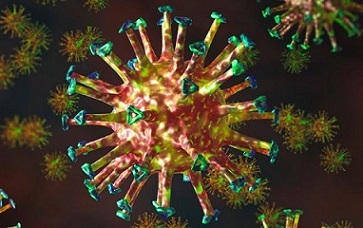BREAKING! SARS-CoV-3 That Poses High Human Threat Identified In Bats In Yunnan Province In China. A Recombinant SARS-CoV-2 And SARS-CoV-1!
COVID-19 News - SARS-CoV-3 Nov 25, 2022 3 years, 4 weeks, 1 day, 9 hours, 39 minutes ago
COVID-19 News: Chinese researchers from Sun Yat-Sen University, Fudan University, Yunnan Institute of Endemic Disease Control and Prevention, Yunnan University, National Institute for Viral Disease Control and Prevention-Beijing, City University of Hong Kong along with Australian scientists from University of Sydney have discovered a recombinant strain of SARS-CoV-2 and SARS-CoV-2 viruses in bats found in the Yunnan province of China.

As the new recombinant coronavirus can effectively utilize the human ACE2 receptor, it poses an immediate high zoonotic risk! Many scientists and
COVID-19 News outlets have already started labelling it as SARS-CoV-3!
In fact, unverified sources are claiming that this new virus is already causing small clusters of infections among people in parts of China. Considering unexplained hard tactics to control the current COVID-19 surges occurring across the country while the West are simply taking a policy of leaning to live with the virus coupled with the fact that China has been reluctant to share genomic sequencing data and also publicly inform what variants and sub-lineages are responsible for the current surges in their country, these claims could well be true!
Bats are reservoir hosts for many zoonotic viruses. Despite this, relatively little is known about the diversity and abundance of viruses within bats at the level of individual animals, and hence the frequency of virus co-infection and inter-species transmission.
Utilizing an unbiased meta-transcriptomics approach, the study team characterized the mammalian associated viruses present in 149 individual bats sampled from Yunnan province, China.
Interestingly, this revealed a high frequency of virus co-infection and species spillover among the animals studied, with 12 viruses shared among different bat species, which in turn facilitates virus recombination and reassortment.
Importantly, the study team identified five viral species that are likely to be pathogenic to humans or livestock, including a novel recombinant SARS-like coronavirus that is closely related to both SARS-CoV-2 and SARS-CoV, with only five amino acid differences between its receptor-binding domain sequence and that of the earliest sequences of SARS-CoV-2.
Detailed functional analysis showed that this recombinant coronavirus can utilize the human ACE2 receptor such that it is likely to be of high zoonotic risk.
The study findings highlight the common occurrence of inter-species transmission and co-infection of bat viruses, as well as their implications for virus emergence.
The study findings were published on a preprint server and are currently being peer reviewed.
https://www.biorxiv.org/content/10.1101/2022.11.23.517609v1
It should be noted that whenever a single cell or organism carries more than one closely related virus at the same time there is a risk of viral crossover.
Hence, various coronaviruses and also other virus species found in bats is a conducive environment for more recombinant and reassortant events.
t;
The study team found two SARS like viruses in the Bats ie BtSY1 and BtSY2 with one being closer related to original SARS-CoV and the other closer to SARS-CoV-2 upon detailed Spike and N gene analysis.
Alarmingly however, upon when looking at the RdRp gene, both BtSY1 and BtSY2 seems to cluster around the SARS-CoV-2 original strain but some regions of BtSY2 are SARS1 like, others SARS2 like, strongly indicating that the virus is a recombinant between SARS-CoV1 and SARS-CoV-2!
Significantly, the receptor binding domain of BtSY2 is (94% identity) is closely identical to the original SARS-CoV2 Wuhan strain and the NTD is even more similar.
The study team using detailed functional analysis found that the Bat SARS-like coronavirus BtSY2 has the ability to bind to the human ACE2 receptor, and even has slightly higher affinity than the original SARS-CoV-2 Wuhan strain, making it an immediate threat to humans.
Three of the five substitutions in the RBD - Q498H, N501Y and H519N - have been reported to increase affinity to human ACE2, and notably, the N501Y substitution is present in the Alpha, Beta, Gamma and Omicron variants of SARS-CoV-2.
In addition, the study team found that the nsp7-nsp14 proteins (in which nsp12 is the replicase, i.e., RdRp) of BtSY2 were closely related to those of SARS-CoV-1.
A comparative study showed that SARS-CoV can replicate more rapidly than SARS-CoV-2 in vitro, while another suggested that nsp14 is likely associated with virulence.
Worryingly, these data tentatively suggest that BtSY2 may be able to replicate rapidly with similar virulence as SARS-CoV. Although this issue merits further consideration, this virus is potentially of high risk of emergence and so should be monitored carefully.
The study team also identified another four viruses of concern, likely to be pathogenic in humans or livestock. Bat SARS-like virus BtSY1 is closely related to SARS-CoV-2, Rhinolophus bat coronavirus HKU2-like is closely related to SADS-CoV, which causes severe diarrhea and death in swine, Rotavirus A causes diarrhea in humans, while Mammalian orthoreovirus is known to have a broad host range and cause diarrhea in swine.
Interestingly, all these viruses of concern were found in more than one bat species in the samples, suggesting that these potentially zoonotic viruses may have a broader host range or have a higher rate of spillover than other viruses.
With mankind invading more and more into natural reservoirs of wild mammals it is only a question of when humans will pick up the next virus(if they have not already done so!) and which one it will be. Recombination of viral genomes is happening and the reservoir of new but closely related species are expanding rapidly.
For the latest
COVID-19 News, keep on logging to Thailand Medical News.
